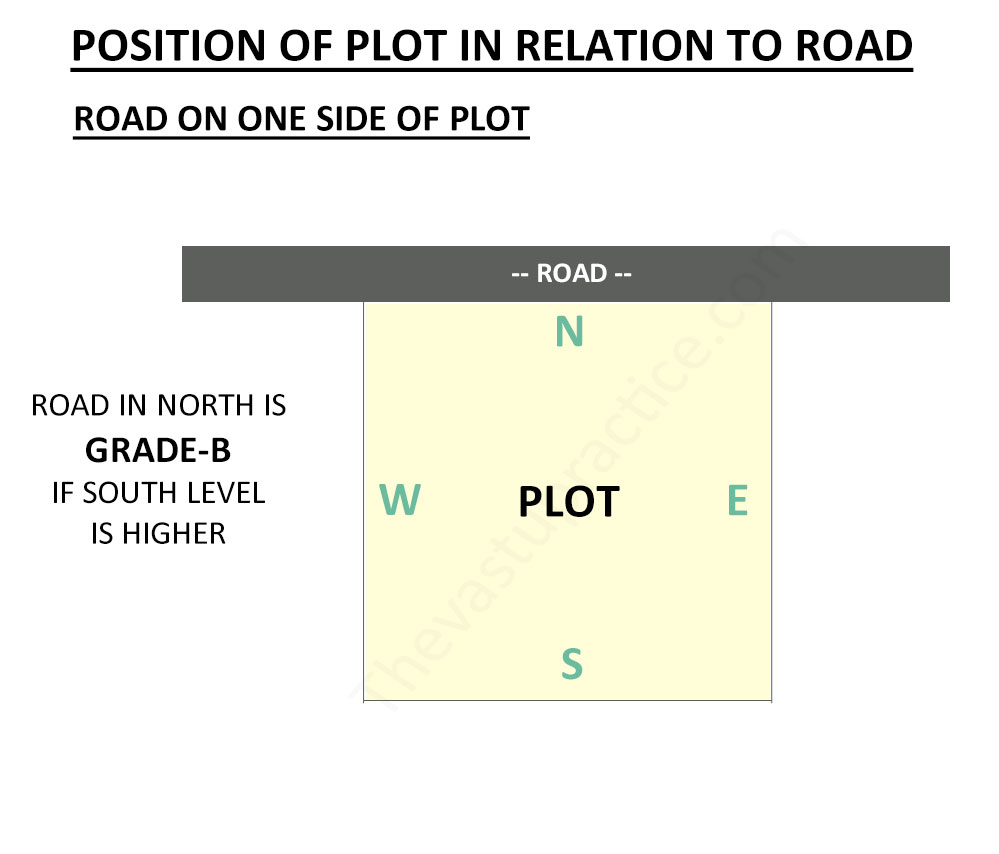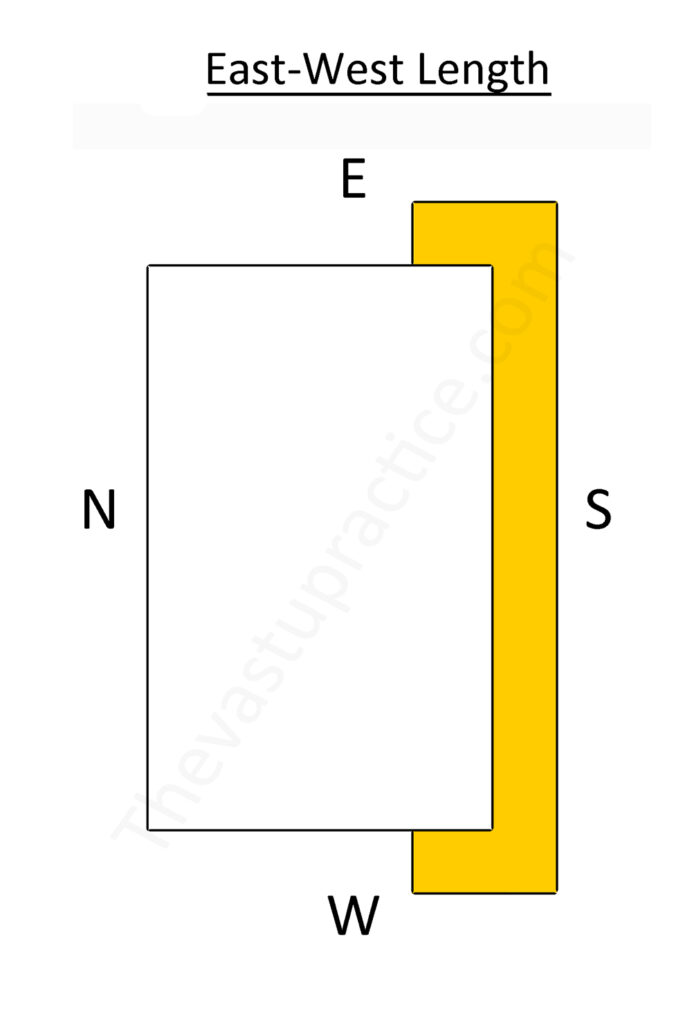Plot with road on South side
- A plot with road in the South is an average or Grade –C plot.
- Such a plot is very good for a business run by a woman or a business dealing in ladies articles.
- Such a plot is also good for entertainment business.

Plot with road on East side
- A plot with a road in the East and the level of plot and road lower toward North-East is a medium or Grade – B plot.
- The level of the plot should be higher and with tall building in the South and West.

Plot with road on North side
- A plot with road in the North and the plot and road sloping toward North-East or if the level of the plot and the road is lower in the North, it is a medium or Grade-B plot.

Plot with roads on two sides North and South
- A plot with roads in the North and South with the level of the plot and the road lower in the North then it is a medium or B-grade plot.
- If the level of the road and the plot is lower in the South then it becomes a bad plot or Grade D plot.

A grade Plot with roads on all four sides
- A plot with roads on all four sides is the best plot.
- It will have additional advantage if the roads in the North and East are lower than the plot.
- If the North-East corner is extended it is still more excellent.
- Doors can be fixed on all four sides in auspicious blocks.
- This is a Grade –A plot.

Lord Shri Ram

He is the seventh incarnation of Vishnu, regarded as Uttam Maryada Purushottam : the best among all men, supreme upholder of social values, the jewel of the Raghuvanshi clan.
The ValmikiRamayan describes him as the sun of the sun, the fire of the fire, the god of the god, the supreme unchanging element, omniscient, omnipresent, incorporeal PrabhoPrabhuie ruler of even those who govern all.
He is described as the embodiment of righteousness and Dharma, the “paramaishwarya” ie the supreme lord of all beings. He is the supreme protector and sustainer who is compassion personified.
According to distinguished Sanskrit scholar Professor Sheldon Pollack, the life of Rama as told in the ancient texts offers a framework to understand the nature of life itself.
The Ramcharitmanas combines mythology, philosophy and religious beliefs into a story of life, a code of ethics and is a treatise on universal human values. It explains human dilemmas, the ideal standards of behavior, duties and responsibilities encouraging the reader to view his own life from a spiritual plane.
The Importance of North-South Axis
A North-South length gives a dynamic active quality to the space inside the structure.
North and East are source directions for energy and the South and West are the sink points of energy.
The North to South electromagnetic flux is known as organic flow or “JaivikUrja”. It is unidirectional and controls the biochemical alignments of all living cell structures.
Thus if the North-South length is more there is free flow of organic energy for a longer duration.
The East zone is the source of “PranicUrja “which has a multidirectional flux.
A greater North-South length also has the capacity to absorb deficiencies in other directions.
Vastu maintains that all activities follow an ordered and disciplined pattern if the North-South axis is greater than the East -West axis.
Most importantly, the perimeter subjected to solar radiation is minimized and results in a cool and healthy environment as can be seen by the following diagrams.


Why House Plants are Important
Houseplants add a lovely aesthetic to homes and offices.
Well cared for house plants are a joy to behold and create a tranquil atmosphere.
They reduce stress levels and increase productivity.
There are many scientific reasons for this:
Plants produce oxygen in the mornings in sunlight and filter air pollutants.
Some plants raise humidity levels by emitting water vapour during transpiration.
Plants produce negative ions similar to many air purifying machines. The negative ions attach themselves to, and effectively remove dust particles, mold spores and other allergens.
Some common houseplants even filter indoor air pollutants like Formaldehyde and Tricholoroethylene used in drycleaning processes and Benzene used in paint, furniture wax etc.
Philodendrons are beautiful with appealing heart shaped leaves and varigations and are very effective in absorbing formaldehyde.
Zanzibar Gem and Philodendron keeping each other company !!

Golden Pothosand Zanzibar Gem are also very effective.
Golden Pothos.

These plants are on NASA’s list of air filtering plants first published in 1989. NASA’s researchers suggest efficient air cleaning is accomplished with at least one plant per 100 square feet of home or office space.
Other indoor plants also in the list are that are beautiful and easy to maintain are Areca palm, Red- edged Dracaena.
Areca Palm thriving indoors.

There is an ongoing debate on whether houseplants are good for the bedroom. Those who feel that they are bad for bedrooms give the reason that plants give out oxygen during the day in the process of photosynthesis but at night the process reverses and plants take in oxygen and emit carbon dioxide.
However plants use very little oxygen and the quantity of carbon dioxide emitted is also marginal .
One small or medium sized plant in the bedroom will not affect sleep patterns or air quality.
Vastu and Mirrors
Note: Always consult a Vastu expert before using a mirror for Vastu correction.
- Mirrors stimulate pranic energy and are widely used as remedies for Vastu correction because they give depth and extend any given direction. When placed correctly mirrors have the power to increase health, wealth and happiness.
- The main door of the house should not be reflected in a mirror.
- Mirrors should only be hung on the East and North walls in the house.
- Mirrors should not be placed opposite one another.
- Always hang a mirror flat against the wall and not leaning forward.
- Only square or rectangular mirrors should be used. Avoid oval, roundor irregular shaped mirrors.


- Avoid mirrors in the bedroom. If this is not possible then keep the mirror covered with a cloth when not in use. The mirror should definitely not reflect the bed.
- Avoid a mirror in children’s study room.

